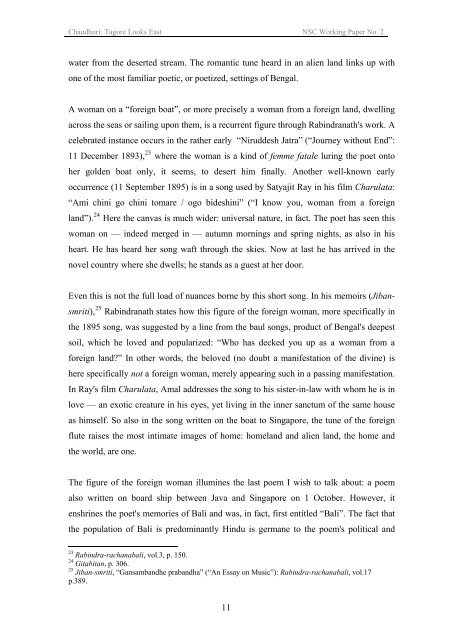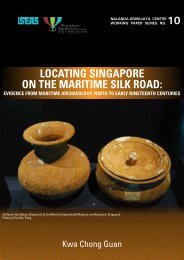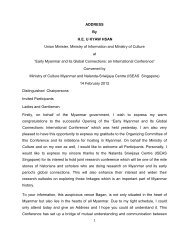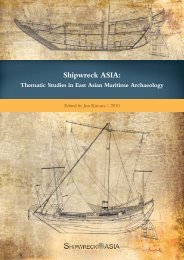2 TAGORE LOOKS EAST - Nalanda-Sriwijaya Centre - iseas
2 TAGORE LOOKS EAST - Nalanda-Sriwijaya Centre - iseas
2 TAGORE LOOKS EAST - Nalanda-Sriwijaya Centre - iseas
- No tags were found...
Create successful ePaper yourself
Turn your PDF publications into a flip-book with our unique Google optimized e-Paper software.
Chaudhuri: Tagore Looks East NSC Working Paper No. 2water from the deserted stream. The romantic tune heard in an alien land links up withone of the most familiar poetic, or poetized, settings of Bengal.A woman on a “foreign boat”, or more precisely a woman from a foreign land, dwellingacross the seas or sailing upon them, is a recurrent figure through Rabindranath's work. Acelebrated instance occurs in the rather early “Niruddesh Jatra” (“Journey without End”:11 December 1893), 23 where the woman is a kind of femme fatale luring the poet ontoher golden boat only, it seems, to desert him finally. Another well-known earlyoccurrence (11 September 1895) is in a song used by Satyajit Ray in his film Charulata:“Ami chini go chini tomare / ogo bideshini” (“I know you, woman from a foreignland”). 24 Here the canvas is much wider: universal nature, in fact. The poet has seen thiswoman on — indeed merged in — autumn mornings and spring nights, as also in hisheart. He has heard her song waft through the skies. Now at last he has arrived in thenovel country where she dwells; he stands as a guest at her door.Even this is not the full load of nuances borne by this short song. In his memoirs (Jibansmriti),25 Rabindranath states how this figure of the foreign woman, more specifically inthe 1895 song, was suggested by a line from the baul songs, product of Bengal's deepestsoil, which he loved and popularized: “Who has decked you up as a woman from aforeign land?” In other words, the beloved (no doubt a manifestation of the divine) ishere specifically not a foreign woman, merely appearing such in a passing manifestation.In Ray's film Charulata, Amal addresses the song to his sister-in-law with whom he is inlove — an exotic creature in his eyes, yet living in the inner sanctum of the same houseas himself. So also in the song written on the boat to Singapore, the tune of the foreignflute raises the most intimate images of home: homeland and alien land, the home andthe world, are one.The figure of the foreign woman illumines the last poem I wish to talk about: a poemalso written on board ship between Java and Singapore on 1 October. However, itenshrines the poet's memories of Bali and was, in fact, first entitled “Bali”. The fact thatthe population of Bali is predominantly Hindu is germane to the poem's political and23 Rabindra-rachanabali, vol.3, p. 150.24 Gitabitan, p. 306.25 Jiban-smriti, “Gansambandhe prabandha” (“An Essay on Music”): Rabindra-rachanabali, vol.17p.389.11
















